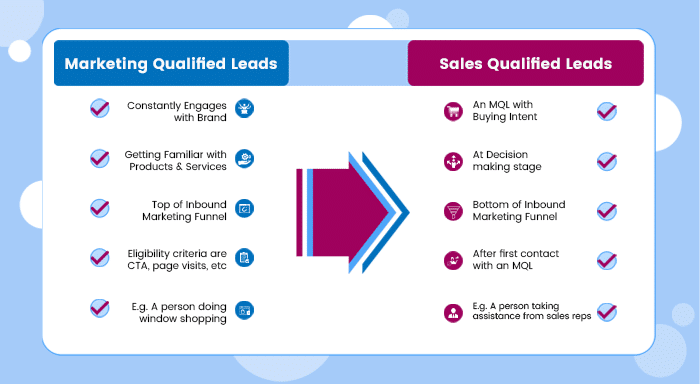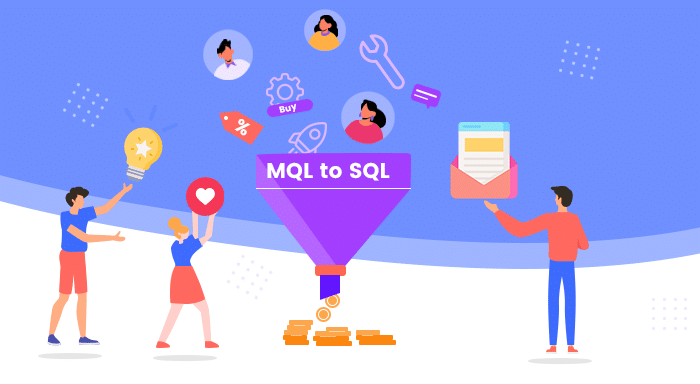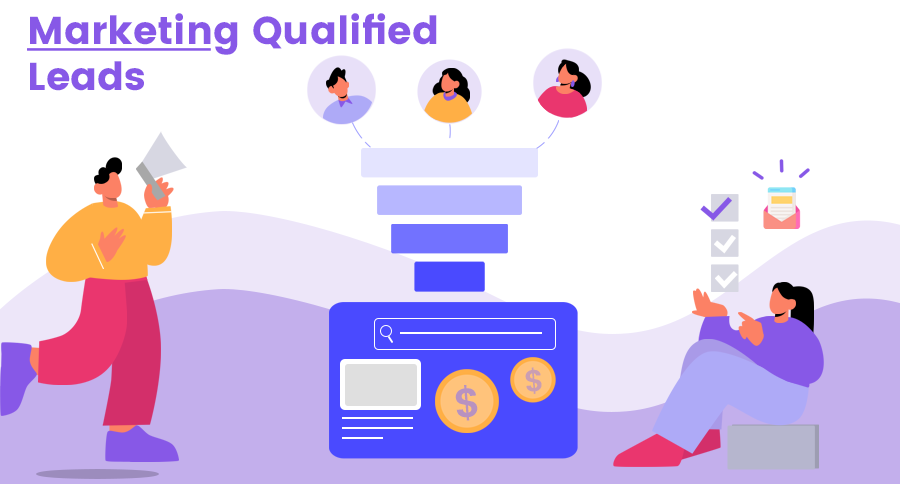An MQL (Marketing Qualified Lead) is a lead that engages with a brand more often than others. These are the leads who are likely to become customers as per the marketing team. Marketers determine the MQL based on certain criteria or actions like frequency of visiting the web pages, voluntarily providing contact information, participating in surveys, adding products to the cart, interacting via various social channels, etc.
But even though these leads are curious about your products and services, they still haven’t fully committed yet. So you can see that these leads are still at the sales conversion stage in the marketing funnel. But as compared to a normal lead, a marketing qualified lead is more likely to actively listen to the sales pitch.
Marketing Qualified Leads Definition
The introduction gives you a faint idea of what is marketing qualified leads. Here, we are going to give you a proper definition of MQL. A marketing qualified lead is a person who is most likely to convert into a customer according to the marketing team. An MQL completely satisfies the buyer’s persona and also checks the other criteria like above-average CTA. But at this stage, the lead is not ready to make a purchase.
Difference Between Marketing Qualified Lead and Sales Qualified Lead
This table shows you the MQL vs SQL comparison with an example.

| MQL | SQL | |
|---|---|---|
| 1 | A MQL is a lead who frequently engages with your brand and can convert into a customer if nurtured correctly. | A SQL is a lead, which is researched by the marketing team, with a high conversion rate. When an MQL is ready to talk with the sales department, it is transferred and called an SQL. |
| 2 | A MQL is curious about the products and services. | A sales qualified lead is genuine intent of purchasing. |
| 3 | An MQL is present at the top of the inbound marketing funnel i.e. attracting and establishing a connection with a visitor. | A SQL is present at the bottom of the inbound marketing funnel i.e. converting leads into customers and then providing them unparalleled after-sales experience. |
| 4 | An MQL is determined based on criteria like lead score, and percentage of CTA (Call to action), frequency of page visits, etc. | A sales qualified lead is determined after the sales rep makes the first contact and verifies the purchasing intent. |
| 5 | Let’s take the example of retail shopping. A marketing qualified lead will browse through products or do window shopping. He/she even goes inside the store, which shows a strengthening in interest. | On the other hand, a sales qualified lead will directly go to the section of need or and ask the staff about the product. |
Now you know the difference between a qualified lead for marketing and a sales qualified lead. However, have you ever thought about why we need to categorize them? This difference between MQL and SQL will let you know how to approach a particular lead, and what content the business should share and even gives you an idea of the nurturing process.
In the next section, we have further elaborated on this topic.
Why Differentiate Between an MQL and SQL?
Suppose there is a lead and he/she has particularly shown interest in your CRM solution then it does not make sense to send the content that demonstrates your entire suite of products. It is not relevant to customers.
Meanwhile, if the lead is still wrapping his/her head around the products and services your business offers then it doesn’t make sense to make a sales call.
Regardless of the case, whether they are not yet decided on which product to purchase or just window shopping, throwing the sales pitch too early will be a waste of time and efforts of the sales team. In addition, you might also end up losing the valuable lead due to a lack of transparency.
On the contrary, if you know whether the leads are MQL or SQL, you can approach them with clear intent. You can map a better lead nurturing strategy based on their engagement with the brand.
This is the surefire way of segmenting the leads based on the micro-criteria like CTR, frequency of visiting web pages, etc. After analyzing all this data, you will be able to know how to approach a particular lead and which content strategy will work best for them. It will bolster the effectiveness of the sales team in the lead conversion process. Also, the marketing team will get a better picture of an ideal customer or buyer's persona.
How does a Marketing Qualified Lead convert into a Sales Qualified Lead?
The difference between a marketing qualified lead and a sales qualified lead is so subtle that only experienced personnel can distinguish them. But it is an important transition in the inbound marketing funnel so you need to do it perfectly.
This transition involved two departments i.e. Marketing and Sales. So you need to make sure that both are on the same page in terms of the MQL and SQL definitions. Every person on the sales and marketing team should know which lead is marketing qualified and which is sales qualified.

Knowing the exact difference will reduce your task to half. For the rest of the procedure, you can follow the roadmap below.
- Marketers declared a lead as MQL: Send some of the lead nurturing content relevant to their actions. You can either send them a direct email or add them to the drip campaign target lists.
- MQL still consuming content: In the ideal situation, the marketing qualified lead is supposed to engage with the content. Here, they could reach out to the marketing personnel or even voluntarily participate in the webinars.
- MQL to SQL: If the marketing qualified lead is still intrigued and constantly engaging then you can hand it over to the sales team. While doing so, you need to make sure to pass on every information you have on that lead. For managing the leads and customer data business uses a CRM (Customer Relationship Management) software. You can look at it as well.
- Sales reps contact SQL: Next, the sales representative will approach the lead and verify if it’s qualified for sale or not.
- There will be 2 scenarios-
- A purchase is made: If a sales rep convinces the leads to make the purchase, they will move to the bottom of the marketing funnel. Now your job is to provide them customer support so they can recommend your business to others.
- No purchase is made: There are chances that leads will not come through, in this case, the sales team will revert the lead status to MQL. And the marketing team further nurtures them until they’re ready for the transition.
The Bottom Line
The entire procedure will help you in finding the highest qualified leads. Marketing teams also gather so much information by providing content to these leads. This data helps businesses to better understand the requirements and intent of the customers. Additionally, the sales team can leverage this information to prepare for their initial steps for approaching the lead. It is a time-saving process for the marketing and sales departments.



